Gold has long been a popular choice for jewelry due to its value and malleability, allowing for intricate designs. Throughout history, people have adorned their rings and necklaces with gems and precious stones, further enhancing the allure of gold jewelry.
Even in modern times, this tradition continues. Jewelry makers often utilize materials like gold, platinum, and silver as a foundation for their creations, incorporating diamonds and other gemstones for added beauty and value.
This article aims to provide a comprehensive understanding of white gold. How was it developed, and why? What are its unique characteristics and potential drawbacks?
Without delay, let’s delve into the subject of white gold, covering everything you need to know. Continue reading to explore this fascinating topic!
DESIGN YOUR OWN ENGAGEMENT RING: START WITH A SETTING OR START WITH A DIAMOND. IT’S REALLY UP TO YOU!
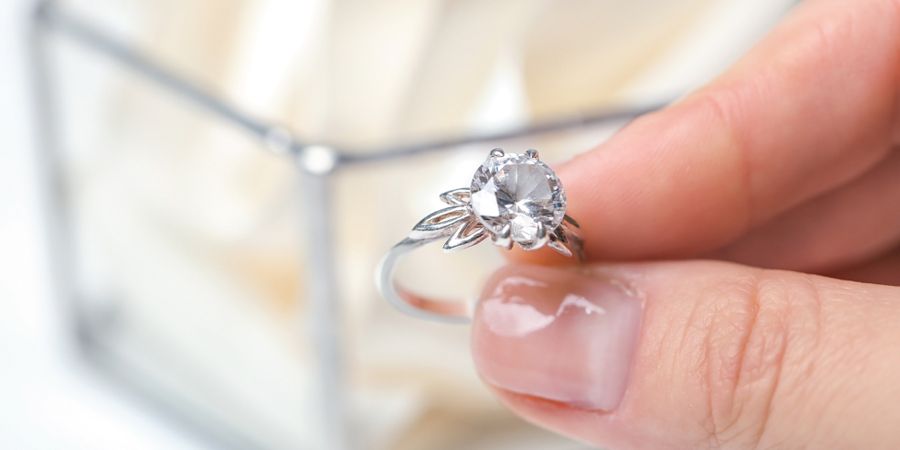
What Is White Gold
White gold has gained immense popularity as a material for jewelry, especially for delicate and intricate pieces, due to its malleability when combined with certain metals.
Contrary to popular belief, white gold is not a pure metal but rather an alloy created by blending pure yellow gold with other metals like palladium, silver, or platinum.
The addition of alloy metals serves two purposes. Firstly, it imparts the desired white color to the gold. Secondly, it enhances the strength and durability of the metal, making it ideal for items that undergo heavy wear, such as rings.
It’s worth noting that all gold jewelry contains some amount of added alloys, including rose, yellow, and white gold, which accounts for their distinct appearances.
Additionally, white gold jewelry is often coated with a precious metal called rhodium, similar to platinum. This coating provides a lustrous surface to the jewelry and offers protection against scratches.
However, it’s important to understand that the rhodium plating on white gold jewelry may gradually wear off over time, revealing the underlying yellow gold hue. Various factors, such as pH levels of the wearer’s skin, frequency of use, and contact with toiletries or chemicals, can influence the rate of wear.
Fortunately, addressing this issue is simple. To restore the original appearance, one can have the jewelry re-coated with rhodium, a process that is affordable and can be done as needed.
It is crucial to dispel the misconception that white gold is not genuine gold. It indeed contains alloys, but the foundation of the material is pure yellow gold, which can be confirmed by examining the jewelry’s hallmark.
The gold content of any gold jewelry, including white, yellow, or rose gold, is measured in “karats.” The karat value indicates the proportion of pure gold used in the composition. For example, a jewelry piece marked as 9K comprises material that is 37.5% pure gold, while 18K jewelry consists of material that is 75% pure gold.
Naturally, higher karat values correspond to higher prices, but we will delve further into this topic later in the article.
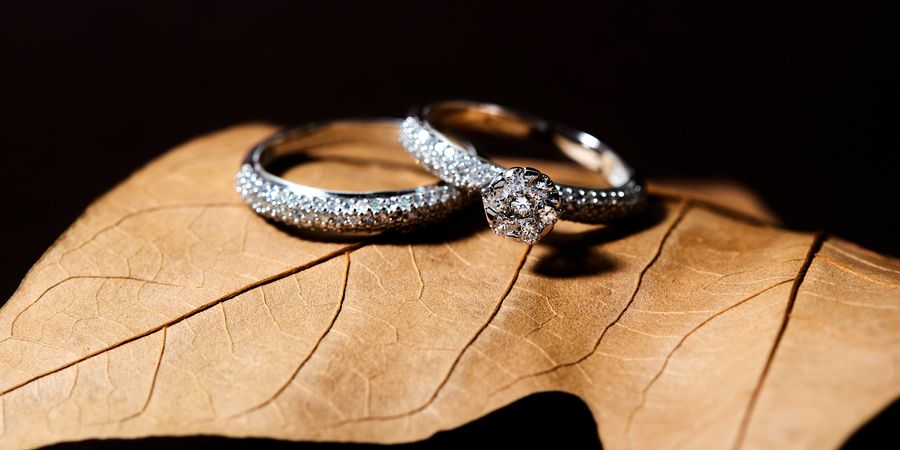
Short History Of White Gold
Throughout history, gold was primarily used in its natural form without the addition of other alloys. The concept of white gold emerged much later, with its origins dating back to 1710 when two alchemists in Germany discovered the process. However, its widespread usage didn’t occur until the 1920s.
Interestingly, white gold gained popularity during times of war, particularly due to the scarcity and utility of platinum. Platinum had long been favored as the primary material for crafting rings, bracelets, and pendants. However, its high cost limited its accessibility to the wealthiest members of society.
During World War II, many countries began utilizing platinum extensively in military industries due to its durability. As a result, there were widespread restrictions on platinum use, especially in the jewelry industry, as it was essential for military applications.
These bans left jewelers worldwide searching for a suitable alternative to fill the void left by platinum. They aimed to create a metal that closely resembled platinum, given its high demand. This led to the exploration and development of various alternatives, with white gold eventually emerging as a successful contender.
While some individuals returned to using platinum after the war, many recognized the potential of white gold. What began as a substitute eventually evolved into one of the most popular materials employed by jewelers worldwide.

How Is White Gold Used Today
Nowadays, white gold has become incredibly popular for various jewelry pieces like rings, bracelets, and necklaces. However, outside of the jewelry industry, it has limited utility.
White gold is often combined with a wide range of materials and gemstones, but its most common pairing is with diamonds. When set in white gold, colorless diamonds appear perfectly white, making it an ideal choice for colorless or near colorless diamonds graded D-J on the color grading scale.
It’s important to note that different diamond shapes may exhibit more or less color. The popular round diamond shape minimizes color visibility, making it suitable for lower color-graded diamonds. However, other diamond shapes may concentrate color at the ends or corners, which can detract from the beauty of low-color diamonds.
Consideration should also be given to the cut of the diamond when selecting a white gold ring. Princess, Emerald, and Asscher cuts tend to minimize color visibility in diamonds.
White gold is particularly favored for wedding and engagement rings, and round and oval cut diamonds pair exceptionally well with white gold settings, especially when the diamonds have higher color grades.
Now, let’s explore different diamond cuts and how they complement white gold settings.
Emerald Cut:
The emerald cut, which dates back to the 15th century, is one of the oldest diamond cuts. Originally used for processing emerald gemstones, it gained popularity for engagement rings. Notably, it has been favored by influential women such as Grace Kelly and Jacqueline Kennedy.
As a “fancy shape” diamond, the emerald cut differs significantly from brilliant cuts. It requires a diamond with high clarity. When combined with white gold, the emerald cut’s staircase effect is enhanced, resulting in a luxurious aesthetic. White gold complements the emerald cut’s aristocratic vibe and is favored by those who appreciate avant-garde jewelry and minimalist styles.
Asscher Cut:
The Asscher cut, invented in 1902 by the Asscher brothers from the Netherlands, gained popularity in the 1920s and experienced a resurgence in the early 2000s due to its vintage appeal. It resembles the emerald cut but features a square shape. The large step facets and high crown produce a unique brilliance.
Asscher cut diamonds are often paired with white gold, particularly in solitaire settings. White gold complements the pale, subtle metal tones commonly used in solitaire settings. The halo setting is another excellent option for Asscher cut diamonds, as it further enhances their sparkle when combined with white gold.
Princess Cut:
The princess cut, also known as the square modified brilliant, is a popular diamond cut frequently used in diamond rings. It was invented in the 1980s and is associated with a classy, feminine design. The princess cut’s downside is its susceptibility to damage due to its sharp corners.
Due to its popularity in engagement rings, the princess cut is often paired with white gold. Halo settings, eternity bands, or contoured bands made of white gold are popular choices. White gold enhances the princess cut’s sparkling effect while providing a sense of elegance and tranquility.
Round Brilliant Cut:
The round brilliant cut, one of the oldest and most recognizable diamond cuts, originated in Belgium in the 15th century. It underwent continuous refinement until it reached its modern form in the early 20th century. Marcel Tolkowsky, a Belgian gemologist and mathematician, developed a formula to maximize the diamond’s brilliance through precise cutting and angling of facets.
The round brilliant cut offers various setting options. The classic six-prong solitaire setting is common, but the halo setting is optimal for showcasing the stone’s natural beauty when paired with white gold. The pavé setting, which incorporates numerous tiny diamonds on the ring band, is another popular choice. When combined with
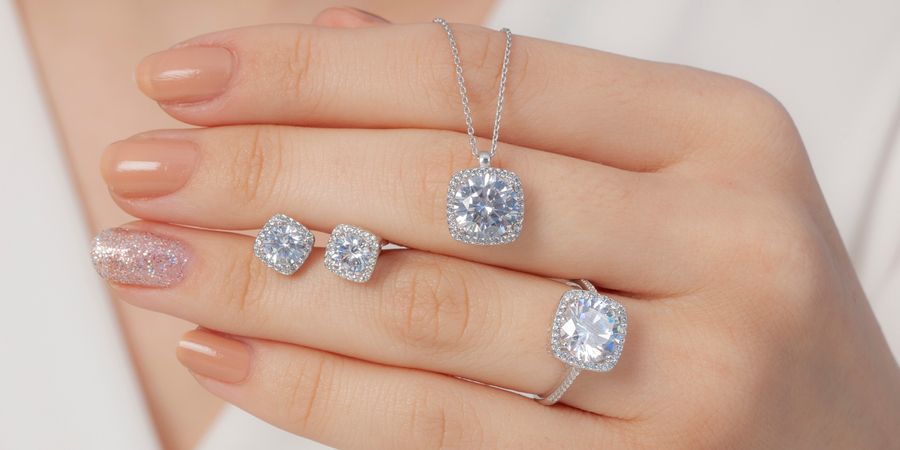
Quick Buying Guide For White Gold
It’s evident that white gold jewelry comes in a wide range of styles due to its popularity. When purchasing white gold, it’s important to note that there are two types: standard and antique.
Standard white gold is an alloy consisting of pure gold and other metals such as palladium and platinum, providing durability and resistance. It does not contain silver.
On the other hand, antique white gold is a combination of pure gold and silver, known for its high glossiness.
When choosing the perfect white gold diamond ring, several factors should be considered, including the stone’s size, shape, setting, and desired gold purity.
These options can significantly impact the price and availability of the ideal ring for you.
Remember that the purity of gold is the main determinant of the band’s price. The higher the gold purity, the more expensive it will be.
Jewelers typically offer 18k white gold, which contains 75% gold and is combined with palladium or platinum. However, there are also options as low as 9k white gold, which contains 32.5% gold and the remaining percentage consists of silver, nickel, or a combination of the two.
Keep in mind that if your ring has a higher gold purity, such as 18k, it may have a slight yellowish tone, making the white gold appear less “white.” Conversely, lower purity levels result in a brighter and whiter appearance.
In the United States, the current price of white gold is approximately $54 per gram for 24k gold, $40 per gram for 18k gold, and $32 per gram for 14k gold.
Of course, when purchasing jewelry, craftsmanship should also be considered, not just the weight of the piece. However, these figures can provide a rough estimate if you’re planning to indulge yourself or someone else with an adornment.
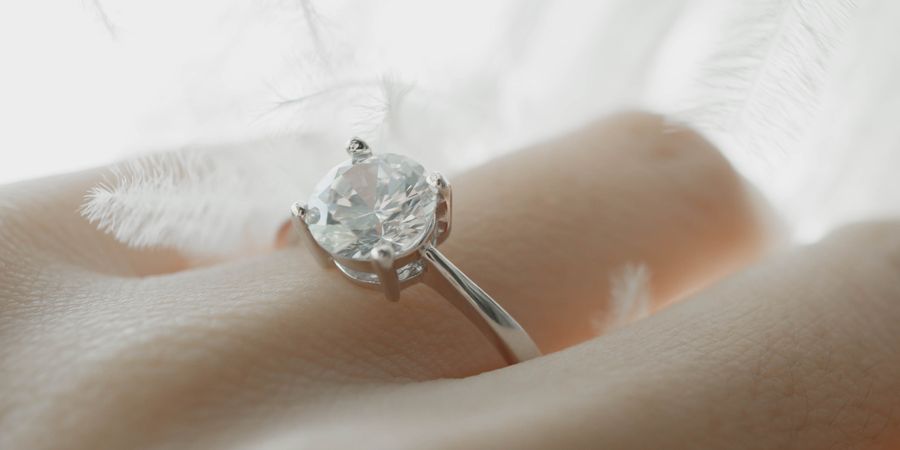
Pros And Cons Of Buying White Gold Jewelry
When it comes to buying white gold, there are certainly pros and cons to consider. While personal taste is the biggest determinant, we have gathered some facts to assist you in making a final decision.
Let’s begin with the positive aspects of white gold:
- White gold is highly popular for wedding and engagement rings, exuding a timeless and elegant feel while maximizing the brilliance of diamonds.
- Its neutral color allows for easy pairing with any diamond and outfit of your choice.
- White gold is often chosen for its affordability compared to platinum, offering similar benefits at a more accessible price point.
- Due to its widespread availability resulting from extensive mining efforts, white gold provides a broader range of options compared to other metals used for wedding and engagement rings, ensuring a wide selection for your preferences.
- White gold surpasses yellow and rose gold in terms of durability and resistance due to the addition of metals such as silver, palladium, or nickel during its creation.
However, despite its popularity, there are a few downsides to consider:
- One significant factor is that white gold is not hypoallergenic. The additional metals in white gold, such as nickel or zinc, may cause skin irritations or trigger allergic reactions in individuals with sensitivities to these metals. In such cases, platinum, a hypoallergenic metal, may be a preferable alternative.
- Another drawback is related to the origin of white gold. As white gold is naturally yellow and achieves its color through the addition of other metals, the yellow hue may resurface over time. Continuous wear of a white gold wedding band can cause it to lose its white appearance within a year or two.
- To maintain the original white color, white gold rings require rhodium plating when the yellowish tint starts to reemerge. Rhodium plating is typically done once or twice a year, depending on factors such as wear duration and chemical interactions with your skin’s pH. While rhodium plating is not overly expensive, it’s important to factor in this maintenance when purchasing white gold jewelry.
Ultimately, your preference and taste remain the most important factors to consider when selecting white gold or any other metal for your jewelry.
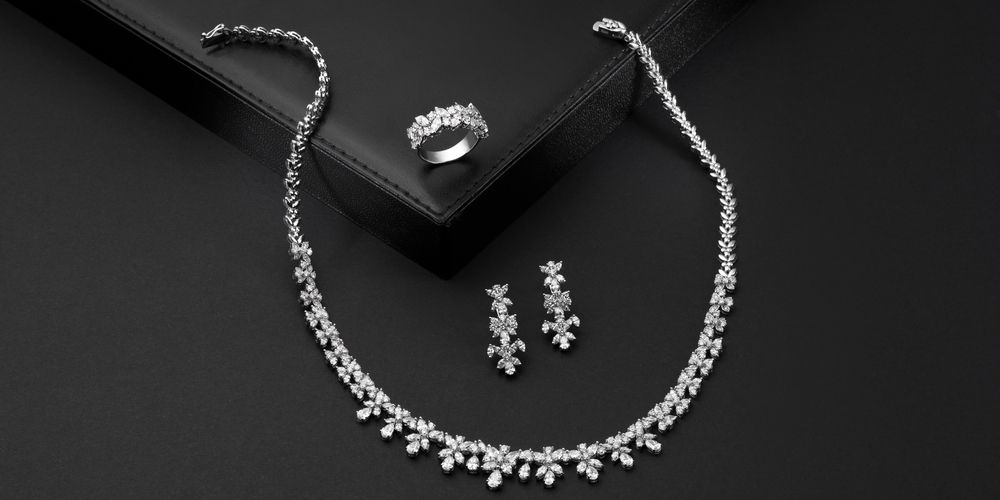
How To Take Care Of Your White Gold Jewelry
Once you’ve made the decision to go for white gold, it’s important to know how to properly maintain your wedding ring or bracelet to preserve its shine over the years of wear. Here are some maintenance tips to help you with that:
- Remember that you need to preserve both the white gold itself and the rhodium plating on your jewelry.
- Cleaning white gold jewelry is a simple process: a. Create a cleaning solution by mixing mild soap and warm water. Avoid detergents with chlorine or harsh chemicals, as they can damage the jewelry. b. Soak your white gold jewelry in the solution for 20-30 minutes. Be cautious not to leave it for too long, as this may cause damage. c. Gently rub the jewelry with a soft cloth to remove dirt. Avoid using rough cloths or brushes, as they can leave scratches. d. Rinse the jewelry with lukewarm water to remove any soap residue that could cause long-term damage. e. Dry the jewelry with a clean towel.
- If your white gold engagement ring or other jewelry piece contains durable gemstones like diamonds, you can follow the cleaning method described above.
- However, if your jewelry includes less durable gemstones such as pearls or onyx stones, avoid submerging them in the cleaning solution. Instead, dip a soft cloth in the cleaning solution, gently rub the metal parts to remove dirt, and then carefully wipe the gemstones with a dry cloth.
- Here are some general tips for maintaining white gold jewelry:
- Avoid wearing it during housework.
- Keep it away from chlorine-based detergents, cleaning agents, and dangerous chemicals like bleach or hydrogen peroxide.
- Remove it before showering or swimming in pools.
- Take it off when working with power tools.
- If your white gold jewelry gets scratched or damaged, you can have it polished by a jeweler to remove the scratches. However, keep in mind that each polishing session affects the rhodium plating.
- Polishing white gold jewelry too frequently can accelerate the wearing off of the rhodium plating. It’s recommended to have the jewelry repolished with rhodium once or twice a year to maintain its appearance. Although it’s not an expensive process, frequent repolishing can add up in cost.
- By following these steps and measures to care for your white gold jewelry, you can ensure its longevity and enjoy it for a lifetime.
Remember, proper maintenance is crucial for preserving the beauty of your white gold jewelry over time.
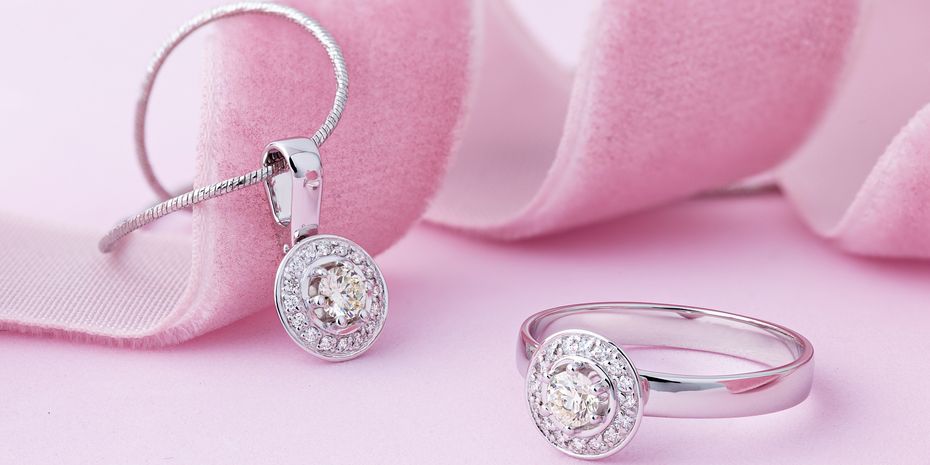
Brief Summary
We hope that this article has provided you with valuable information about white gold and its important aspects. However, this is just the beginning of exploring the various facets of this popular metal.
In summary, white gold is created by combining natural yellow gold with metals like zinc, palladium, or silver to enhance its durability and achieve its distinctive white color.
White gold is available in a wide range of purities, ranging from 9k (the lowest) to 24k (the highest).
For wedding and engagement rings, white gold is an excellent choice due to its superior durability compared to yellow and rose gold, as well as its ability to enhance the brilliance and sparkle of various diamond cuts.
This marks the end of our journey through the world of white gold, providing you with essential knowledge. We encourage you to continue your exploration and delve deeper into topics like these. Our hope is that you are now one step closer to selecting the perfect piece of jewelry that aligns with your preferences and requirements.


